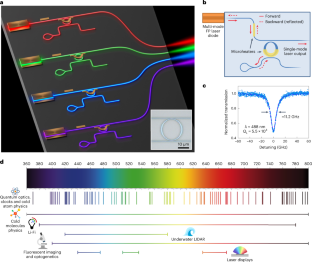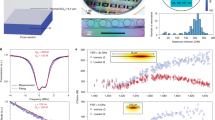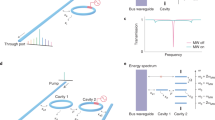Abstract
Widely tunable and narrow-linewidth lasers at visible wavelengths are necessary for applications such as quantum optics, optical clocks and atomic and molecular physics. At present, the lasers are benchtop systems, which precludes these technologies from being used outside research laboratories. Here we demonstrate a chip-scale visible laser platform that enables tunable and narrow-linewidth lasers from near-ultraviolet to near-infrared wavelengths. Using micrometre-scale silicon nitride resonators and commercial Fabry–Pérot laser diodes, we achieve coarse tuning up to 12.5 nm and mode-hop-free fine tuning up to 33.9 GHz with intrinsic linewidths down to a few kilohertz. In addition, we show fine-tuning speeds of up to 267 GHz µs−1, fibre-coupled powers of up to 10 mW and typical side-mode suppression ratios above 35 dB. These specifications of our chip-scale lasers have only been achieved previously using large state-of-the-art benchtop laser systems, making our lasers stand out as powerful tools for the next generation of visible-light technologies.
This is a preview of subscription content, access via your institution
Access options
Access Nature and 54 other Nature Portfolio journals
Get Nature+, our best-value online-access subscription
$29.99 / 30 days
cancel any time
Subscribe to this journal
Receive 12 print issues and online access
$209.00 per year
only $17.42 per issue
Buy this article
- Purchase on Springer Link
- Instant access to full article PDF
Prices may be subject to local taxes which are calculated during checkout





Similar content being viewed by others
Data availability
The experimental dataset and its analysis are provided within the paper and its Supplementary Information, and the data are available from the corresponding authors upon reasonable request.
References
Niffenegger, R. J. et al. Integrated multi-wavelength control of an ion qubit. Nature 586, 538–542 (2020).
Moody, G. et al. Roadmap on integrated quantum photonics. JPhys. Photonics 4, 012501 (2022).
Mehta, K. K. et al. Integrated optical multi-ion quantum logic. Nature 586, 533–537 (2020).
Kómár, P. et al. A quantum network of clocks. Nat. Phys. 10, 582–587 (2014).
Nichol, B. C. et al. An elementary quantum network of entangled optical atomic clocks. Nature 609, 689–694 (2022).
Tomza, M. et al. Cold hybrid ion–atom systems. Rev. Mod. Phys. 91, 035001 (2019).
Gross, C. & Bloch, I. Quantum simulations with ultracold atoms in optical lattices. Science 357, 995–1001 (2017).
Mitra, D., Leung, K. H. & Zelevinsky, T. Quantum control of molecules for fundamental physics. Phys. Rev. A 105, 040101 (2022).
Will, S. et al. Time-resolved observation of coherent multi-body interactions in quantum phase revivals. Nature 465, 197–201 (2010).
Campbell, S. L. et al. A Fermi-degenerate three-dimensional optical lattice clock. Science 358, 90–94 (2017).
Oelker, E. et al. Demonstration of 4.8 × 10−17 stability at 1 s for two independent optical clocks. Nat. Photonics 13, 714–719 (2019).
Moriya, P. H. et al. Comparison between 403 nm and 497 nm repumping schemes for strontium magneto-optical traps. J. Phys. Commun. 2, 125008 (2018).
Ding, R. et al. Creation of vibrationally-excited ultralong-range Rydberg molecules in polarized and unpolarized cold gases of 87Sr. J. Phys. B 53, 014002 (2019).
Young, A. W. et al. Half-minute-scale atomic coherence and high relative stability in a tweezer clock. Nature 588, 408–413 (2020).
Bowden, W. et al. A pyramid MOT with integrated optical cavities as a cold atom platform for an optical lattice clock. Sci. Rep. 9, 11704 (2019).
Bongs, K. et al. Development of a strontium optical lattice clock for the SOC mission on the ISS. C. R. Phys. 16, 553–564 (2015).
Lai, Y.-H. et al. 780 nm narrow-linewidth self-injection-locked WGM lasers. Proc. SPIE 11266, 112660O (2020).
Savchenkov, A. A. et al. Application of a self-injection locked cyan laser for barium ion cooling and spectroscopy. Sci. Rep. 10, 16494 (2020).
Donvalkar, P. S., Savchenkov, A. & Matsko, A. Self-injection locked blue laser. J. Opt. 20, 045801 (2018).
Savchenkov, A. A. et al. Self-injection locking efficiency of a UV Fabry–Perot laser diode. Opt. Lett. 44, 4175–4178 (2019).
Franken, C. A. A. et al. Hybrid-integrated diode laser in the visible spectral range. Opt. Lett. 46, 4904–4907 (2021).
Chauhan, N. et al. Ultra-low loss visible light waveguides for integrated atomic, molecular, and quantum photonics. Opt. Express 30, 6960–6969 (2022).
Chauhan, N. et al. Visible light photonic integrated Brillouin laser. Nat. Commun. 12, 4685 (2021).
Morin, T. J. et al. CMOS-foundry-based blue and violet photonics. Optica 8, 755–756 (2021).
Corato-Zanarella, M. et al. Overcoming the trade-off between loss and dispersion in microresonators. In Conference on Lasers and Electro-Optics paper STh1J.1 (Optica Publishing Group, 2020); https://doi.org/10.1364/CLEO_SI.2020.STh1J.1
Liang, G. et al. Robust, efficient, micrometre-scale phase modulators at visible wavelengths. Nat. Photonics 15, 908–913 (2021).
Li, X., Deng, Q. & Zhou, Z. Low loss, high-speed single-mode half-disk resonator. Opt. Lett. 39, 3810–3813 (2014).
Ji, X. et al. Ultra-low-loss on-chip resonators with sub-milliwatt parametric oscillation threshold. Optica 4, 619–624 (2017).
Payne, F. P. & Lacey, J. P. R. A theoretical analysis of scattering loss from planar optical waveguides. Opt. Quantum Electron. 26, 977–986 (1994).
Gil-Molina, A. et al. Robust hybrid III-V/Si3N4 laser with kHz-linewidth and GHz-pulling range. In Conference on Lasers and Electro-Optics paper STu3M.4 (Optica Publishing Group, 2020); https://doi.org/10.1364/CLEO_SI.2020.STu3M.4
Kondratiev, N. M. et al. Self-injection locking of a laser diode to a high-Q WGM microresonator. Opt. Express 25, 28167–28178 (2017).
Galiev, R. R. et al. Spectrum collapse, narrow linewidth, and Bogatov effect in diode lasers locked to high-Q optical microresonators. Opt. Express 26, 30509–30522 (2018).
Raja, A. S. et al. Electrically pumped photonic integrated soliton microcomb. Nat. Commun. 10, 680 (2019).
Li, B. et al. Reaching fiber-laser coherence in integrated photonics. Opt. Lett. 46, 5201–5204 (2021).
Xiang, C. et al. Laser soliton microcombs heterogeneously integrated on silicon. Science 373, 99–103 (2021).
Snigirev, V. et al. Ultrafast tunable lasers using lithium niobate integrated photonics. Preprint at https://arxiv.org/abs/2112.02036 (2022).
Lihachev, G. et al. Low-noise frequency-agile photonic integrated lasers for coherent ranging. Nat. Commun. 13, 3522 (2022).
Guo, J. et al. Chip-based laser with 1-hertz integrated linewidth. Sci. Adv. 8, eabp9006 (2022).
Shamim, M. H. M. et al. Investigation of self-injection locked visible laser diodes for high bit-rate visible light communication. IEEE Photonics J. 10, 7905611 (2018).
Shamim, M. H. M., Ng, T. K., Ooi, B. S. & Khan, M. Z. M. Tunable self-injection locked green laser diode. Opt. Lett. 43, 4931–4934 (2018).
Hult, J., Burns, I. S. & Kaminski, C. F. Wide-bandwidth mode-hop-free tuning of extended-cavity GaN diode lasers. Appl. Opt. 44, 3675–3685 (2005).
Schkolnik, V., Fartmann, O. & Krutzik, M. An extended-cavity diode laser at 497 nm for laser cooling and trapping of neutral strontium. Laser Phys. 29, 035802 (2019).
Li, C. et al. High-speed multi-pass tunable diode laser absorption spectrometer based on frequency-modulation spectroscopy. Opt. Express 26, 29330–29339 (2018).
Riemensberger, J. et al. Massively parallel coherent laser ranging using a soliton microcomb. Nature 581, 164–170 (2020).
Idjadi, M. H. & Aflatouni, F. Integrated Pound–Drever–Hall laser stabilization system in silicon. Nat. Commun. 8, 1209 (2017).
Spencer, D. T., Davenport, M. L., Komljenovic, T., Srinivasan, S. & Bowers, J. E. Stabilization of heterogeneous silicon lasers using Pound–Drever–Hall locking to Si3N4 ring resonators. Opt. Express 24, 13511–13517 (2016).
Stéphan, G. M., Tam, T. T., Blin, S., Besnard, P. & Têtu, M. Laser line shape and spectral density of frequency noise. Phys. Rev. A 71, 043809 (2005).
Kharas, D. et al. High-power (>300 mW) on-chip laser with passively aligned silicon-nitride waveguide DBR cavity. IEEE Photonics J. 12, 1504612 (2020).
Billah, M. R. et al. Hybrid integration of silicon photonics circuits and InP lasers by photonic wire bonding. Optica 5, 876–883 (2018).
Nielsen, M. D., Folkenberg, J. R., Mortensen, N. A. & Bjarklev, A. Bandwidth comparison of photonic crystal fibers and conventional single-mode fibers. Opt. Express 12, 430–435 (2004).
Hong, S. & Ali, S. Compact arrayed waveguide gratings for visible wavelengths based on silicon nitride. Ukr. J. Phys. Opt. 18, 239 (2017).
Andrews, J. R. Enhanced thermal stability of single longitudinal mode coupled cavity lasers. Appl. Phys. Lett. 47, 71–73 (1985).
Wieman, C. E. & Hollberg, L. Using diode lasers for atomic physics. Rev. Sci. Instrum. 62, 1–20 (1991).
Doret, S. C. Simple, low-noise piezo driver with feed-forward for broad tuning of external cavity diode lasers. Rev. Sci. Instrum. 89, 023102 (2018).
Dutta, S., Elliott, D. S. & Chen, Y. P. Mode-hop-free tuning over 135 GHz of external cavity diode lasers without antireflection coating. Appl. Phys. B 106, 629–633 (2012).
Spencer, D. T., Bauters, J. F., Heck, M. J. R. & Bowers, J. E. Integrated waveguide coupled Si3N4 resonators in the ultrahigh-Q regime. Optica 1, 153–157 (2014).
Ji, X. et al. Exploiting ultralow loss multimode waveguides for broadband frequency combs. Laser Photonics Rev. 15, 2000353 (2021).
Antman, Y. et al. High power on-chip integrated laser. Preprint at https://arxiv.org/abs/2207.06279 (2022).
Siddharth, A. et al. Near ultraviolet photonic integrated lasers based on silicon nitride. APL Photonics 7, 046108 (2022).
Petermann, K. Laser Diode Modulation and Noise (Springer, 1988).
Acknowledgements
This work was supported as part of the Novel Chip-Based Nonlinear Photonic Sources from the Visible to Mid-Infrared funded by the Army Research Office under award no. W911NF2110286. Fabrication of the photonic chips was done in part at the City University of New York Advanced Science Research Center Nanofabrication Facility, in part at the Columbia Nano Initiative Shared Lab Facilities at Columbia University, and in part at the Cornell NanoScale Facility, a member of the National Nanotechnology Coordinated Infrastructure (NNCI), which is supported by the National Science Foundation (Grant NNCI-2025233). M.C.S. is supported by a Facebook Fellowship Award. We thank A. Gaeta, S. Will and his group members M. Kwon and W. Yuan, and T. Zelevinsky and her students Q. Sun and K. H. Leung for lending critical pieces of equipment and for helpful discussions. We also thank U. D. Dave, G. R. Bhatt and Y. Antman for helpful discussions. M.C.-Z. thanks N. Janosik for her support and helpful discussions.
Author information
Authors and Affiliations
Contributions
M.C.-Z. conceived the chip-scale visible lasers research project. M.C.-Z., A.G.-M. and A.M. had the initial discussions that shaped the first steps and goals of the project. With helpful suggestions from A.G.-M., M.C.-Z. designed the photonic devices and experiments. M.C.-Z., X.J. and M.C.S. fabricated the photonic chips. M.C.-Z. and A.M. performed experiments on some preliminary devices. M.C.-Z. performed the experimental measurements and analysed the results, with crucial suggestions from A.G.-M. along the way. M.C.-Z. prepared the manuscript. X.J., A.G.-M., M.C.S., A.M. and M.L. edited the manuscript. M.L. supervised the project.
Corresponding authors
Ethics declarations
Competing interests
M.C.-Z., A.G.-M, X.J., M.C.S., A.M. and M.L. are named inventors on US provisional patent application 63/275,141 regarding the technology reported in this article.
Peer review
Peer review information
Nature Photonics thanks the anonymous reviewers for their contribution to the peer review of this work.
Additional information
Publisher’s note Springer Nature remains neutral with regard to jurisdictional claims in published maps and institutional affiliations.
Supplementary information
Supplementary Information
Supplementary Sections 1–6, Figs. 1–43 and Tables 1–11.
Rights and permissions
Springer Nature or its licensor (e.g. a society or other partner) holds exclusive rights to this article under a publishing agreement with the author(s) or other rightsholder(s); author self-archiving of the accepted manuscript version of this article is solely governed by the terms of such publishing agreement and applicable law.
About this article
Cite this article
Corato-Zanarella, M., Gil-Molina, A., Ji, X. et al. Widely tunable and narrow-linewidth chip-scale lasers from near-ultraviolet to near-infrared wavelengths. Nat. Photon. 17, 157–164 (2023). https://doi.org/10.1038/s41566-022-01120-w
Received:
Accepted:
Published:
Issue Date:
DOI: https://doi.org/10.1038/s41566-022-01120-w
This article is cited by
-
Inorganic perovskite-based active multifunctional integrated photonic devices
Nature Communications (2024)
-
Active mid-infrared ring resonators
Nature Communications (2024)
-
Synthetic reflection self-injection-locked microcombs
Nature Photonics (2024)
-
On-Chip Micro Temperature Controllers Based on Freestanding Thermoelectric Nano Films for Low-Power Electronics
Nano-Micro Letters (2024)
-
Integrated titanium:sapphire laser
Nature Photonics (2023)



